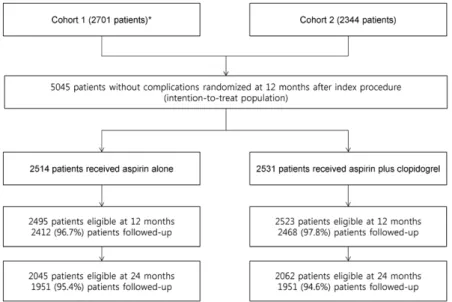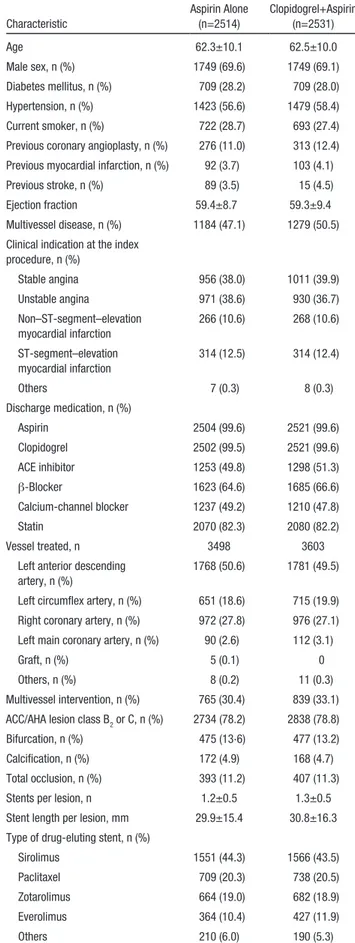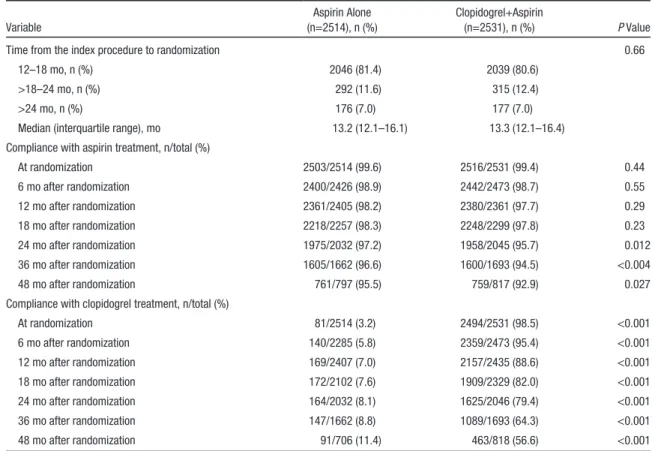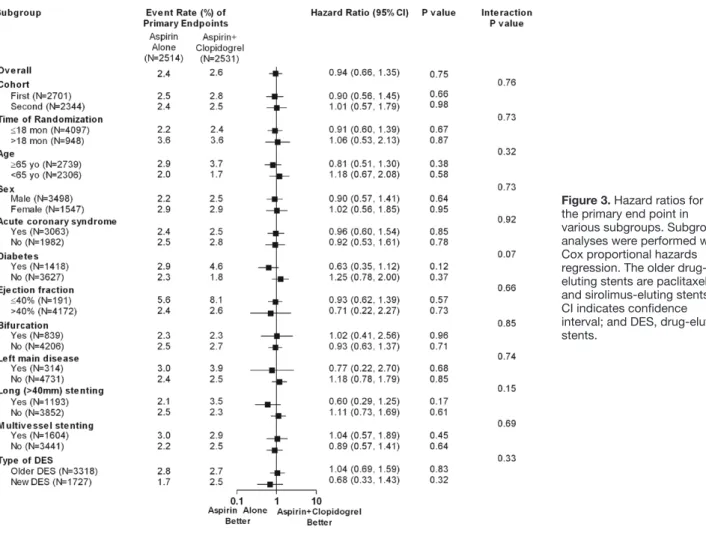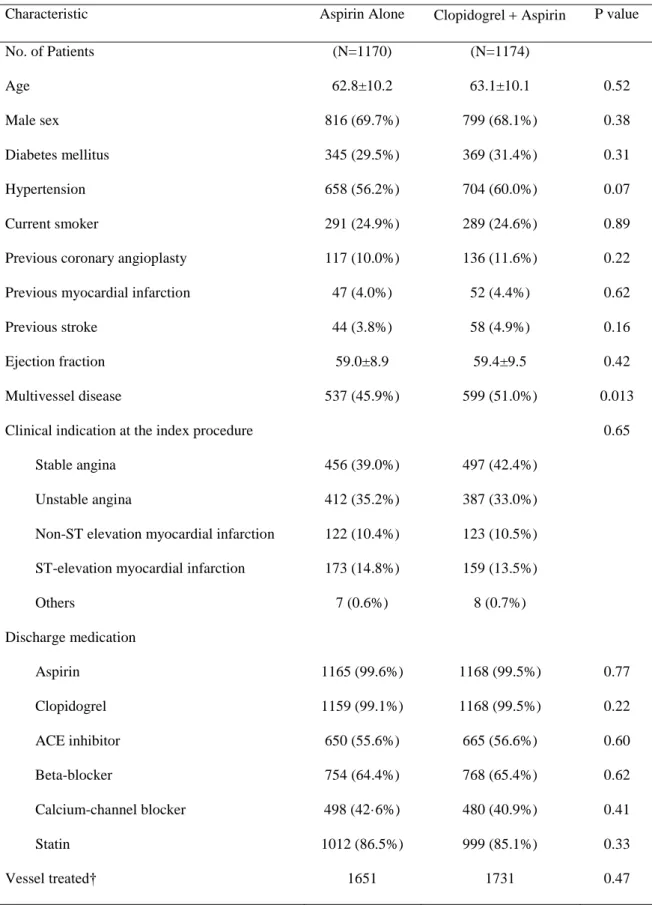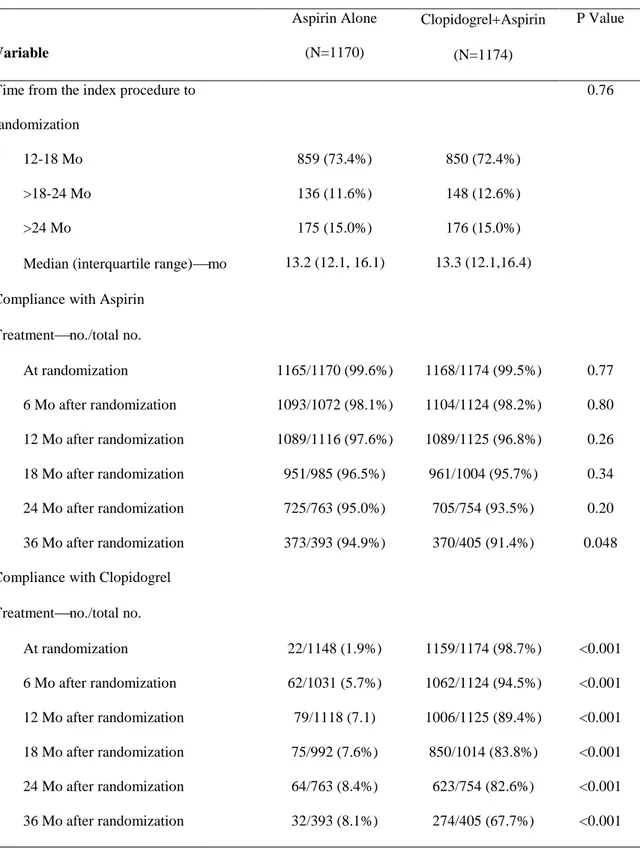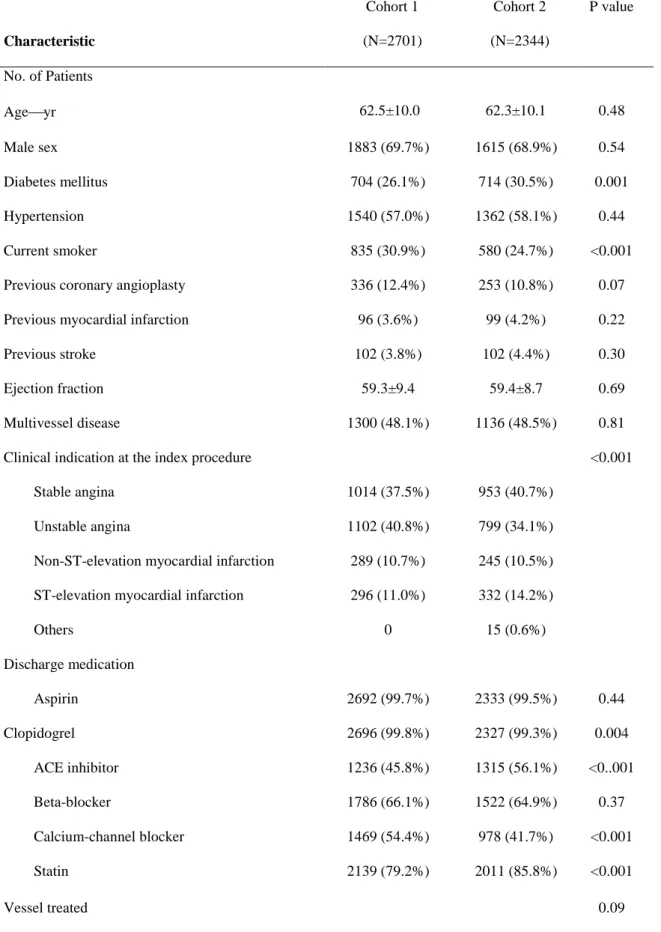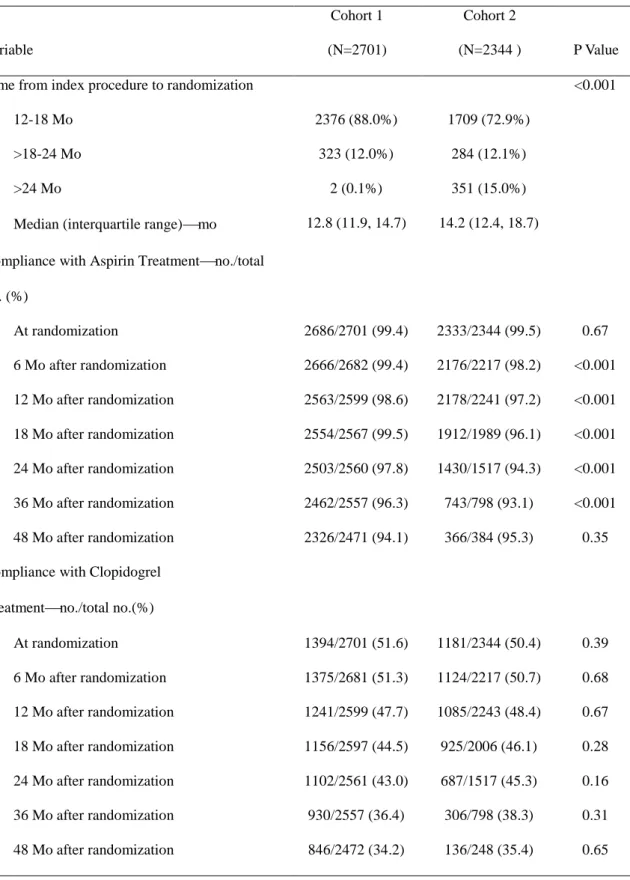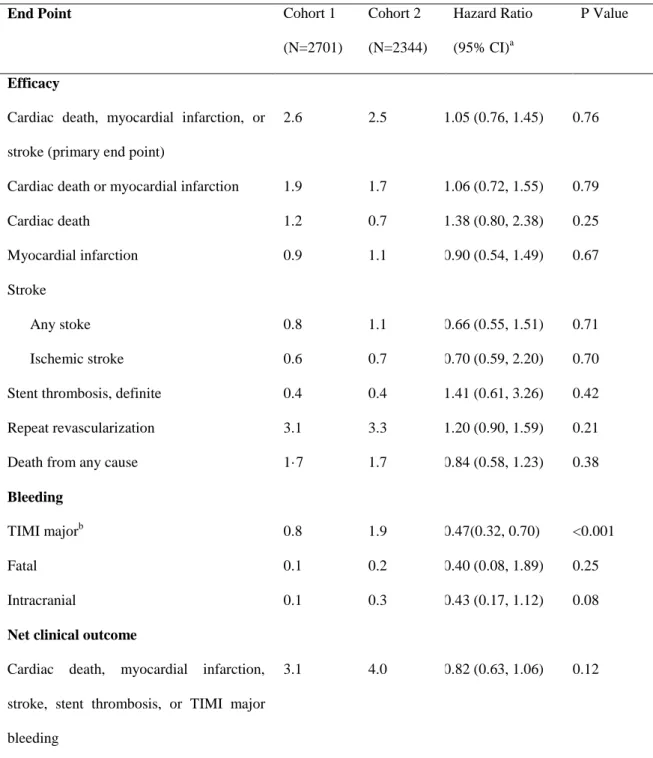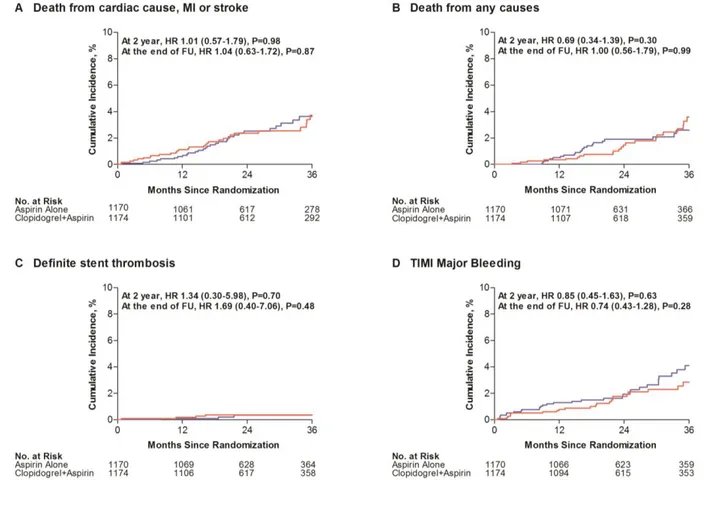304
D rug-eluting stents have been shown to be superior to bare metal stents in terms of patient outcome in that they are
associated with lower repeat revascularization rates and simi- lar rates of death and myocardial infarction.
1–3However, there Background—The risks and benefits of long-term dual antiplatelet therapy remain unclear.
Methods and Results—This prospective, multicenter, open-label, randomized comparison trial was conducted in 24 clinical centers in Korea. In total, 5045 patients who received drug-eluting stents and were free of major adverse cardiovascular events and major bleeding for at least 12 months after stent placement were enrolled between July 2007 and July 2011.
Patients were randomized to receive aspirin alone (n=2514) or clopidogrel plus aspirin (n=2531). The primary end point was a composite of death resulting from cardiac causes, myocardial infarction, or stroke 24 months after randomization.
At 24 months, the primary end point occurred in 57 aspirin-alone group patients (2.4%) and 61 dual-therapy group patients (2.6%; hazard ratio, 0.94; 95% confidence interval, 0.66–1.35; P=0.75). The 2 groups did not differ significantly in terms of the individual risks of death resulting from any cause, myocardial infarction, stent thrombosis, or stroke. Major bleeding occurred in 24 (1.1%) and 34 (1.4%) of the aspirin-alone group and dual-therapy group patients, respectively (hazard ratio, 0.71; 95% confidence interval, 0.42–1.20; P=0.20).
Conclusions—Among patients who were on 12-month dual antiplatelet therapy without complications, an additional 24 months of dual antiplatelet therapy versus aspirin alone did not reduce the risk of the composite end point of death from cardiac causes, myocardial infarction, or stroke.
Clinical Trial Registration—URL: http://www.clinicaltrials.gov. Unique identifier: NCT01186146.
(Circulation. 2014;129:304-312.)
Key Words: aspirin ◼ clopidogrel ◼ coronary disease ◼ stents
© 2013 American Heart Association, Inc.
Circulation is available at http://circ.ahajournals.org DOI: 10.1161/CIRCULATIONAHA.113.003303
Continuing medical education (CME) credit is available for this article. Go to http://cme.ahajournals.org to take the quiz.
Received May 16, 2013; accepted October 1, 2013.
From The Heart Institute, University of Ulsan College of Medicine, Asan Medical Center, Seoul (C.W.L., J.-M.A., D.-W.P., S.-J.K., S.-W.L., Y.-H.K., S.-W.P., S.-J.P.); Division of Biostatistics, Center for Medical Research and Information, University of Ulsan College of Medicine, Asan Medical Center, Seoul (S.H.); Ulsan University Hospital, Ulsan (S.-G.L.); Chungnam National University Hospital, Daejeon (I.-W. Seong); Korea University Guro Hospitals, Seoul (S.-W.R.); Chonnam National University Hospital, Gwangju (M.-H.J.); Korea University Anam Hospitals, Seoul (D.-S.L.); Yonsei University Wonju College of Medicine, Wonju Christian Hospital, Wonju (J.-H.Y.); Keimyung University Dongsan Medical Center, Daegu (S.-H.H.); Catholic University of Korea, Yeouido St. Mary’s Hospital, Seoul (Y.-S.C.); National Health Insurance Corp, Ilsan Hospital, Ilsan (J.-Y.Y.); Soon Chun Hyang University Hospital Bucheon, Bucheon (N.-H.L.); Hallym University Sacred Heart Hospital, Anyang (H.-S.K.); Kangwon National University Hospital, Chuncheon (B.-K.L.);
Daegu Catholic University Medical Center, Daegu (K.-S.K.); Kwangju Christian Hospital, Kwangju (S.-U.L.); Chonbuk National University Hospital, Jeonju (J.-K.C.); GangNeung Asan Medical Center, Gangneung (S.-S.C.); Sam Anyang Hospital, Anyang (I.-W. Suh); Kyungpook National University Hospital, Daegu (H.-S.P.); Dongguk University Gyeongju Hospital, Gyeongju (D.-Y.N.); Catholic University of Korea, Incheon St. Mary’s Hospital, Incheon (D.-S.J.); Catholic University of Korea, Seoul St. Mary’s Hospital, Seoul (K.-B.S.); Veterans Hospital Service Medical Center, Seoul (K.L.); and Inje University College of Medicine, Busan Paik Hospital, Busan (J.-S.J.), South Korea.
*Drs Lee and Ahn contributed equally.
The online-only Data Supplement is available with this article at http://circ.ahajournals.org/lookup/suppl/doi:10.1161/CIRCULATIONAHA.
113.003303/-/DC1.
Correspondence to Seung-Jung Park, MD, PhD, Division of Cardiology, Heart Institute, Asan Medical Center, University of Ulsan, 88 Olympic-ro, 43 gil, Songpa-gu, Seoul, 138–736, Korea. E-mail sjpark@amc.seoul.kr
Optimal Duration of Dual Antiplatelet Therapy After Drug-Eluting Stent Implantation
A Randomized, Controlled Trial
Cheol Whan Lee, MD*; Jung-Min Ahn, MD*; Duk-Woo Park, MD; Soo-Jin Kang, MD;
Seung-Whan Lee, MD; Young-Hak Kim, MD; Seong-Wook Park, MD; Seungbong Han, PhD;
Sang-Gon Lee, MD; In-Whan Seong, MD; Seung-Woon Rha, MD; Myung-Ho Jeong, MD;
Do-Sun Lim, MD; Jung-Han Yoon, MD; Seung-Ho Hur, MD; Yun-Seok Choi, MD;
Joo-Young Yang, MD; Nae-Hee Lee, MD; Hyun-Sook Kim, MD; Bong-Ki Lee, MD;
Kee-Sik Kim, MD; Seung-Uk Lee, MD; Jei-Keon Chae, MD; Sang-Sig Cheong, MD;
Il-woo Suh, MD; Hun-Sik Park, MD; Deuk-Young Nah, MD; Doo-Soo Jeon, MD;
Ki-Bae Seung, MD; Keun Lee, MD; Jae-Sik Jang, MD; Seung-Jung Park, MD, PhD
by guest on February 11, 2016 http://circ.ahajournals.org/
Downloaded from http://circ.ahajournals.org/ by guest on February 11, 2016 Downloaded from http://circ.ahajournals.org/ by guest on February 11, 2016 Downloaded from http://circ.ahajournals.org/ by guest on February 11, 2016 Downloaded from http://circ.ahajournals.org/ by guest on February 11, 2016 Downloaded from http://circ.ahajournals.org/ by guest on February 11, 2016 Downloaded from http://circ.ahajournals.org/ by guest on February 11, 2016 Downloaded from http://circ.ahajournals.org/ by guest on February 11, 2016 Downloaded from http://circ.ahajournals.org/ by guest on February 11, 2016 Downloaded from http://circ.ahajournals.org/ by guest on February 11, 2016 Downloaded from http://circ.ahajournals.org/ by guest on February 11, 2016 Downloaded from http://circ.ahajournals.org/ by guest on February 11, 2016 Downloaded from http://circ.ahajournals.org/ by guest on February 11, 2016 Downloaded from http://circ.ahajournals.org/ by guest on February 11, 2016 Downloaded from http://circ.ahajournals.org/ by guest on February 11, 2016 Downloaded from http://circ.ahajournals.org/ by guest on February 11, 2016 Downloaded from http://circ.ahajournals.org/ by guest on February 11, 2016 Downloaded from http://circ.ahajournals.org/ by guest on February 11, 2016 Downloaded from http://circ.ahajournals.org/ by guest on February 11, 2016 Downloaded from http://circ.ahajournals.org/ by guest on February 11, 2016 Downloaded from http://circ.ahajournals.org/ by guest on February 11, 2016 Downloaded from
Lee et al Antiplatelet Therapy After DES Implantation 305
is concern about the risk of late stent thrombosis after drug- eluting stent implantation.
4,5After the safety and efficacy of these devices were extensively evaluated, it was suggested that prolonged dual antiplatelet therapy should be given for at least 12 months after implantation of drug-eluting stents.
6Clinical Perspective on p 312
At present, the guidelines recommend that dual antiplate- let therapy should be given either for 6 to 12 months
7or for at least 12 months
8after drug-eluting stent implantation unless patients are at high risk for bleeding. However, these recommendations are based largely on registry data,
9–11and the optimal duration of dual antiplatelet therapy remains poorly defined. Currently, large-scale, randomized, clini- cal trials are being performed to address questions about the appropriate duration of dual antiplatelet therapy in patients who have received drug-eluting stents.
12,13We have previously reported that, compared with aspirin alone, continuation of dual antiplatelet therapy for >12 months after drug-eluting stent implantation is not beneficial.
14Furthermore, the long-term dual-therapy arm was associ- ated with a trend toward increased risk of cardiac death, myocardial infarction, and stroke. To confirm this obser- vation, the Optimal Duration of Clopidogrel Therapy With DES to Reduce Late Coronary Arterial Thrombotic Event (DES LATE) trial was designed. In this trial, we tested the hypothesis that 12-month dual antiplatelet therapy may provide better protection against cardiovascular events than
>12 months of dual antiplatelet therapy after implantation of drug-eluting stents.
Methods Trial Design
DES LATE was a prospective, multicenter, open-label, random- ized comparison trial conducted in 24 clinical centers in Korea.
The study, an extension of the previously conducted research,14 was the result of the executive committee’s recommendation to clarify our previous findings (DES LATE; www.clinicaltrials.gov; number NCT01186146). The data and safety monitoring board allowed the
seamless extension of the first trial. The study overview was sum- marized in Figure 1 (the online-only Data Supplement provides a detailed description of the study extension), and the study inves- tigators were the same as in the first trial. The study was approved by the institutional review board at each institution, and written informed consent was obtained from all participants. DES LATE was an investigator-initiated trial without any company involvement in the design or execution of the trial or in the analysis or reporting of the data.
Eligible Criteria
Patients were eligible for participation in the study if they had under- gone implantation with drug-eluting stents at least 12 months before enrollment, had not had a major adverse cardiovascular event (myo- cardial infarction, stroke, or repeat revascularization) or major bleed- ing since implantation, and were receiving dual antiplatelet therapy at the time of enrollment. The time from the index procedure to randomization ranged from 12 to 18 months. The exclusion criteria included contraindications to the use of antiplatelet drugs, concomi- tant vascular disease that required the long-term use of clopidogrel or other established indications for clopidogrel therapy (eg, recent acute coronary syndrome), and noncardiac coexisting conditions with a life expectancy of <1 year.
Randomization and Treatment Schema
Patients were randomly allocated to receive either low-dose aspi- rin alone (100 to 200 mg/d) or clopidogrel (75 mg/d) plus low-dose aspirin. The treatment group assignments were made according to a pre-established, computer-generated randomization scheme that involved stratification on the basis of the site and the type of drug in the drug-eluting stent. Because the trial was an open-label trial, the study subjects and the investigators were aware of the treatment assignments. All patients also received the drug with the appropriate standard of care, which was provided at the investigator’s discretion.
The investigators were reapprised of the appropriate evidence-based background medical therapy that is based on contemporary interna- tional guidelines.8
Follow-up evaluations were performed every 6 months. At these visits, the data pertaining to patient clinical status, interventions, adverse events, and drug compliance were recorded. To ensure accu- rate assessment of compliance with the study medication regimen, patients were asked whether they were taking aspirin, whether they were taking clopidogrel, how many tablets they were taking, and how long they had been taking them. If any antiplatelet medication had
Figure 1. Study overview. REAL-LATE indicates REAL-world patients treated with drug- eluting stent implantation and Late coronary Arterial Thrombotic Events; and ZEST-LATE, Zotarolimus-Eluting stent, Sirolimus-eluting stent, or pacliTaxel-eluting stent implantation for coronary lesions-Late coronary Arterial Thrombotic Events.
by guest on February 11, 2016 http://circ.ahajournals.org/
Downloaded from
306 Circulation January 21, 2014
been discontinued, an attempt was made to determine the specific timing of this action. If there was uncertainty about the timing, the referring cardiologist or general practitioner was contacted for addi- tional information.
End Points
The primary end point was a composite of death resulting from car- diac causes, myocardial infarction, or stroke 24 months after ran- domization. The secondary end points were death from any cause;
myocardial infarction; stroke; stent thrombosis; repeat revascular- ization; a composite of death resulting from cardiac causes or myo- cardial infarction; a composite of death from any cause, myocardial infarction, or stroke; major bleeding according to the Thrombolysis in Myocardial Infarction (TIMI) definition15; and a composite of death resulting from cardiac causes, myocardial infarction, stent thrombo- sis, stroke, or TIMI major bleeding.
All deaths were considered to have resulted from cardiac causes unless an unequivocal noncardiac cause could be established. The diagnosis of acute myocardial infarction was based on the univer- sal definition of myocardial infarction.16 Stroke, as detected by the occurrence of a new neurological deficit, was confirmed by a neurologist and imaging. Stent thrombosis was defined as the defi- nite occurrence of a thrombotic event according to the Academic Research Consortium classification.17 Repeat revascularization was defined as any percutaneous or surgical revascularization procedure regardless of whether it was performed on a target or nontarget lesion. All reported efficacy and safety outcomes were confirmed by a central adjudication committee that was unaware of the treatment assignments.
Statistical Analysis
The sample size was calculated by assuming primary end-point incidences of 1.3% and 2.7% for the aspirin-alone and dual-therapy groups, respectively (relative risk, 0.5), at 24 months with the log- rank test.14 A final sample size of 5000 patients for 2 groups would provide a statistical power of 80% with a 2-sided α level of 0.05 on the assumption that 10% would be lost to follow-up.
The data for all patients enrolled in the first cohort and the extended second cohort were included in the analysis, and all analy- ses were based on the intention-to-treat principle by an independent statistician (S.H.). Differences between the 2 treatment groups were evaluated by use of the Student t test for continuous variables and the χ2 or Fisher exact test for categorical variables. Cumulative event rates were calculated by use of the Kaplan-Meier method, and a Cox proportional hazards model was used to compare the 2 groups in terms of the clinical end points when the stratification variable was the cohort. To determine whether merging of the data from the 2 cohorts would be appropriate, we conducted a homogeneity test using a likelihood test, indicating that the assumption of homoge- neity was not violated (χ2=0.034; df=1; P=0.85). The proportional hazards assumption on treatment assignments was confirmed by use of the Schoenfeld residuals test; no relevant violations of the assumption were found. Analyses were performed by an indepen- dent statistician who was unaware of the treatment assignments. R software version 15.1 was used for this assessment. All reported P values are 2 sided, and values of P<0.05 were considered to indicate statistical significance.
Results Study Participants
Between July 2007 and July 2011, a total of 5045 patients were recruited in the trial: 2701 patients in the first cohort (July 2007–September 2009) and 2344 patients in the sec- ond cohort (August 2010–July 2011). Of these, 2514 were randomly assigned to receive aspirin-alone therapy, and the remaining 2531 received dual antiplatelet therapy.
Table 1. Baseline Characteristics of the Patients Characteristic
Aspirin Alone (n=2514)
Clopidogrel+Aspirin (n=2531)
Age 62.3±10.1 62.5±10.0
Male sex, n (%) 1749 (69.6) 1749 (69.1)
Diabetes mellitus, n (%) 709 (28.2) 709 (28.0) Hypertension, n (%) 1423 (56.6) 1479 (58.4) Current smoker, n (%) 722 (28.7) 693 (27.4) Previous coronary angioplasty, n (%) 276 (11.0) 313 (12.4) Previous myocardial infarction, n (%) 92 (3.7) 103 (4.1)
Previous stroke, n (%) 89 (3.5) 15 (4.5)
Ejection fraction 59.4±8.7 59.3±9.4
Multivessel disease, n (%) 1184 (47.1) 1279 (50.5) Clinical indication at the index
procedure, n (%)
Stable angina 956 (38.0) 1011 (39.9)
Unstable angina 971 (38.6) 930 (36.7)
Non–ST-segment–elevation myocardial infarction
266 (10.6) 268 (10.6) ST-segment–elevation
myocardial infarction
314 (12.5) 314 (12.4)
Others 7 (0.3) 8 (0.3)
Discharge medication, n (%)
Aspirin 2504 (99.6) 2521 (99.6)
Clopidogrel 2502 (99.5) 2521 (99.6)
ACE inhibitor 1253 (49.8) 1298 (51.3)
β-Blocker 1623 (64.6) 1685 (66.6)
Calcium-channel blocker 1237 (49.2) 1210 (47.8)
Statin 2070 (82.3) 2080 (82.2)
Vessel treated, n 3498 3603
Left anterior descending artery, n (%)
1768 (50.6) 1781 (49.5)
Left circumflex artery, n (%) 651 (18.6) 715 (19.9) Right coronary artery, n (%) 972 (27.8) 976 (27.1) Left main coronary artery, n (%) 90 (2.6) 112 (3.1)
Graft, n (%) 5 (0.1) 0
Others, n (%) 8 (0.2) 11 (0.3)
Multivessel intervention, n (%) 765 (30.4) 839 (33.1) ACC/AHA lesion class B2 or C, n (%) 2734 (78.2) 2838 (78.8)
Bifurcation, n (%) 475 (13·6) 477 (13.2)
Calcification, n (%) 172 (4.9) 168 (4.7)
Total occlusion, n (%) 393 (11.2) 407 (11.3)
Stents per lesion, n 1.2±0.5 1.3±0.5
Stent length per lesion, mm 29.9±15.4 30.8±16.3 Type of drug-eluting stent, n (%)
Sirolimus 1551 (44.3) 1566 (43.5)
Paclitaxel 709 (20.3) 738 (20.5)
Zotarolimus 664 (19.0) 682 (18.9)
Everolimus 364 (10.4) 427 (11.9)
Others 210 (6.0) 190 (5.3)
Data are mean± SD when appropriate. ACC/AHA indicates American College of Cardiology/American Heart Association; and ACE, angiotensin-converting enzyme.
by guest on February 11, 2016 http://circ.ahajournals.org/
Downloaded from
Lee et al Antiplatelet Therapy After DES Implantation 307
The 2 patient groups were largely similar in terms of their baseline characteristics (Table 1 and Tables I–IV in the online- only Data Supplement). The mean age of the whole cohort was 62.4±10.0 years; 69% (3498 of 5045) were men; 58%
(2902 of 5045) had a history of hypertension; 28% (1418 of 5045) had diabetes mellitus; 28% (1415 of 5045) were current smokers; 48% (2436 of 5045) had multivessel diseases; and 61% (3063 of 5045) had acute coronary syndrome at the time of the index procedure. Older-generation drug-eluting stents (paclitaxel- and sirolimus-eluting stents) were used in 64%
(4564 of 7101) of the treated lesions, whereas new-generation drug-eluting stents were used in the remaining 36% (2537 of 7101) of the treated lesions. Most patients were enrolled between 12 and 18 months after implantation of drug-eluting stents (Table 2).
Follow-up
The median length of follow-up after randomization was 42.0 months (interquartile range, 24.7–50.7 months). Follow-up was complete for 97.2% (4880 of 5018), 95% (3902 of 4107), and 87.7% (1663 of 1897) of the eligible patients at 12, 24, and 48 months, respectively (Figure 1).
During the course of the study, adherence to the assigned study treatment in the aspirin-alone group was 98.2 % (2361 of 2405) and 97.2 % (1975 of 2032) at 12 and 24 months, respectively. In the aspirin-alone group, 8.1% of patients were taking dual antiplatelet therapy at 24 months. For the dual- therapy group, these adherence rates were 88.6% (2157 of
2435) and 79.4% (1625 of 2046), respectively (Table 2 and Table IV in the online-only Data Supplement).
End Points
The primary end point of death resulting from cardiac causes, myocardial infarction, or stroke at 24 months occurred in 57 aspirin-alone group patients (2.4%) and 61 dual-therapy group patients (2.6%; hazard ratio, 0.94; 95% confidence interval [CI], 0.66–1.35; P=0.75; Table 3). The 2 groups were also similar in terms of cumulative rates of the primary end point through the entire treatment period (Figure 2A and Tables V–VIII in the online-only Data Supplement). The results were the same after adjustment for the factors that showed imbal- ance during the randomization. Age and sex did not affect the relationships between the treatments and the primary end point; this was also true for the prespecified subgroups (Figure 3). Similar findings were observed in cohort 2 (Table VI and Figure I in the online-only Data Supplement), and an interaction between the 2 cohorts in terms of the primary end point was not found (P for interaction=0.76).
At 24 months, death resulting from any cause occurred in 32 aspirin-alone group patients (1.4%) and 46 dual-therapy group patients (2.0%; hazard ratio, 0.71; 95% CI, 0.45–1.10;
P=0.12; Table 3 and Figure 2B). Definite stent thrombosis
occurred in 11 aspirin-alone group patients (0.5%) and 7 dual-therapy group patients (0.3%; hazard ratio, 1.59; 95%
CI, 0.61–4.09; P=0.34; Table 3 and Figure 2C). The 2 groups also had similar results in terms of the other secondary clinical outcomes (Table 3).
Table 2. Timing of Randomization and Adherence to the Study Medication(s) in the Clopidogrel+Aspirin and Aspirin-Alone Groups
Variable
Aspirin Alone (n=2514), n (%)
Clopidogrel+Aspirin
(n=2531), n (%) P Value
Time from the index procedure to randomization 0.66
12–18 mo, n (%) 2046 (81.4) 2039 (80.6)
>18–24 mo, n (%) 292 (11.6) 315 (12.4)
>24 mo, n (%) 176 (7.0) 177 (7.0)
Median (interquartile range), mo 13.2 (12.1–16.1) 13.3 (12.1–16.4)
Compliance with aspirin treatment, n/total (%)
At randomization 2503/2514 (99.6) 2516/2531 (99.4) 0.44
6 mo after randomization 2400/2426 (98.9) 2442/2473 (98.7) 0.55
12 mo after randomization 2361/2405 (98.2) 2380/2361 (97.7) 0.29
18 mo after randomization 2218/2257 (98.3) 2248/2299 (97.8) 0.23
24 mo after randomization 1975/2032 (97.2) 1958/2045 (95.7) 0.012
36 mo after randomization 1605/1662 (96.6) 1600/1693 (94.5) <0.004
48 mo after randomization 761/797 (95.5) 759/817 (92.9) 0.027
Compliance with clopidogrel treatment, n/total (%)
At randomization 81/2514 (3.2) 2494/2531 (98.5) <0.001
6 mo after randomization 140/2285 (5.8) 2359/2473 (95.4) <0.001
12 mo after randomization 169/2407 (7.0) 2157/2435 (88.6) <0.001
18 mo after randomization 172/2102 (7.6) 1909/2329 (82.0) <0.001
24 mo after randomization 164/2032 (8.1) 1625/2046 (79.4) <0.001
36 mo after randomization 147/1662 (8.8) 1089/1693 (64.3) <0.001
48 mo after randomization 91/706 (11.4) 463/818 (56.6) <0.001
by guest on February 11, 2016 http://circ.ahajournals.org/
Downloaded from
308 Circulation January 21, 2014
Bleeding Outcomes
At 24 months, TIMI major bleeding occurred in 24 aspirin-alone group patients (1.1%) and 34 dual-therapy group patients (1.4%;
hazard ratio, 0.71; 95% CI, 0.42–1.20; P=0.20; Table 3). However, by the end of the follow-up period, the aspirin-alone group had a lower rate of TIMI major bleeding than the dual-therapy group (hazard ratio, 0.67; 95% CI, 0.47–0.95; P=0.026; Figure 2D).
There was no significant heterogeneity across all major sub- groups, except that cohort 2 exhibited a higher rate of TIMI major bleeding (Table VII in the online-only Data Supplement).
The net clinical outcome of death from cardiac causes, myocardial infarction, stent thrombosis, stroke, or TIMI major bleeding occurred in 74 aspirin-alone group patients (3.2%) and 89 dual-therapy group patients (3.8%; hazard ratio, 0.84;
95% CI, 0.62–1.14; P=0.26; Table 3).
Discussion
The DES LATE study showed that, in stable patients receiv- ing drug-eluting stents, aspirin monotherapy compared with dual antiplatelet therapy for >12 months did not reduce the risk of death resulting from cardiac causes, myocardial infarc- tion, or stroke. However, aspirin monotherapy was associated with lower risk of TIMI major bleeding during the follow-up period. These findings suggest that the 2 antiplatelet strategies provide similar protection against ischemic events with less risk of bleeding in aspirin monotherapy.
In a registry study from Duke University, patients who had received drug-eluting stents and were then given clopidogrel for >12 months had a lower risk of death or myocardial infarc- tion than those who received clopidogrel for <12 months; this was not observed for patients who received bare metal stents.
10In other registry studies, however, the use of dual antiplate- let therapy for >12 months after drug-eluting stent implanta- tion did not reduce the rate of death, myocardial infarction, stent thrombosis, or stroke.
9,11In contrast to these inconsistent observational studies, several small randomized studies have shown that dual antiplatelet therapy for >6 to 12 months after drug-eluting stent implantation is similar to aspirin mono- therapy in terms of rates of death, myocardial infarction, stent thrombosis, or stroke.
18–22These studies included the Efficacy of Xience/Promus Versus Cypher to Reduce Late Loss After Stenting (EXCELLENT) trial, in which 1443 patients who had received drug-eluting stents were given 6 or 12 months of dual antiplatelet therapy. The 6-month therapy was not inferior to the 12-month therapy in terms of the rate of target vessel failure at 12 months.
18Similarly, in the Prolonging Dual Antiplatelet Treatment After Grading Stent-Induced Intimal Hyperplasia Study (PRODIGY) trial, 2013 patients were treated with 4 dif- ferent types of stents and then randomly allocated to receive 6 or 24 months of clopidogrel therapy in addition to aspirin.
19There was no benefit associated with continuing clopido- grel therapy compared with discontinuing clopidogrel after 6 months. However, dual antiplatelet therapy for 24 months was
Table 3. Efficacy and Bleeding Outcomes at the 24-Month Follow-upEnd Point
Cumulative Event Rate at 24 mo Aspirin Alone
(n=2514)
Clopidogrel+ Aspirin (n=2531)
Hazard Ratio
(95% CI)* P Value Efficacy
Cardiac death, myocardial infarction, or stroke (primary end point)
57 (2.4) 61 (2.6) 0.94 (0.66–1.35) 0.75
Death, myocardial infarction, or stroke 69 (3.0) 78 (3.3) 0.89 (0.65–1.24) 0.49 Cardiac death or myocardial infarction 41 (1.8) 43 (1.9) 0.96 (0.63–1.48) 0.86 Death
Death from any cause 32 (1.4) 46 (2.0) 0.71 (0.45–1.10) 0.12
Cardiac death 19 (0.8) 28 (1.2) 0.68 (0.38–1.23) 0.20
Myocardial infarction 27 (1.2) 19 (0.8) 1.43 (0.80–2.58) 0.23
Stroke
Any stoke 21 (0.9) 21 (0.9) 1.01 (0.55–1.85) 0.98
Ischemic stroke 13 (0.6) 15 (0.6) 0.88 (0.42–1.84) 0.73
Stent thrombosis, definite 11 (0.5) 7 (0.3) 1.59 (0.61–4.09) 0.34
Repeat revascularisation 65 (2.8) 81 (3.5) 0.81 (0.58–1.12) 0.20
Bleeding
TIMI major† 24 (1.1) 34 (1.4) 0.71 (0.42–1.20) 0.20
Fatal 4 (0.2) 1 (0.04) 4.02 (0.45–36.0) 0.21
Intracranial 3 (0.1) 5 (0.2) 0.60 (1.44–2.52) 0.49
Net clinical outcome
Cardiac death, myocardial infarction, stroke, stent thrombosis, or TIMI major bleeding
74 (3.2) 89 (3.8) 0.84 (0.62–1.14) 0.26
CI indicates confidence interval; and TIMI, Thrombolysis in Myocardial Infarction.
*The hazard ratio for 24-month follow-up period is for the aspirin-alone group compared with the dual-therapy group.
†TIMI major bleeding refers to events that were adjudicated on the basis of previously used TIMI criteria.15
by guest on February 11, 2016 http://circ.ahajournals.org/
Downloaded from
Lee et al Antiplatelet Therapy After DES Implantation 309
associated with a significantly higher bleeding rate. Moreover, the recent Real Safety and Efficacy of a 3-Month Dual Antiplatelet Therapy Following E-ZES Implantation (RESET) trial showed that 3 months of dual antiplatelet therapy after Endeavor zotarolimus-eluting stent implantation was not infe- rior to 12 months of dual antiplatelet therapy after implantation with other drug-eluting stents.
20However, all studies to date are underpowered for the detection of significant differences in hard clinical outcomes because of the small numbers of patients and the low numbers of clinical events.
Our previous report showed that dual antiplatelet therapy for >12 months after drug-eluting stent implantation was not more effective than aspirin monotherapy in terms of reduc- ing the rate of the primary end point of death resulting from cardiac causes or myocardial infarction.
14Moreover, the dual- therapy group tended to have a higher risk of the combined end point of death resulting from cardiac causes, myocardial infarction, or stroke than the aspirin-alone group (hazard ratio, 1.84; 95% CI, 0.99–3.45; P=0.06). Although these unexpected findings are probably attributable to chance, similar findings have been noted in several other studies,
15,23,24which indicates the need for caution when selecting between potent antiplatelet therapies. In the large Clopidogrel for High Atherothrombotic Risk and Ischemic Stabilization, Management, and Avoidance (CHARISMA) trial, patients with multiple risk factors who received aspirin plus clopidogrel had a higher rate of death resulting from cardiovascular causes than the patients who received aspirin alone (3.9% versus 2.2%; P=0.01).
23It has been speculated that intraplaque hemorrhage may cause rapid
plaque progression with acute ischemic events.
25,26In the pres- ent study, however, dual antiplatelet therapy did not increase the risk of the composite end point of death resulting from cardiac causes, myocardial infarction, or stroke at 24 months compared with aspirin alone. The groups also did not differ sig- nificantly in terms of the individual risks of death resulting from any cause, myocardial infarction, stent thrombosis, or stroke.
Subgroup analysis revealed that long-term dual antiplatelet therapy did not provide extra benefits to patients with high-risk features such as left main coronary artery disease, bifurcation disease, diffuse disease, multivessel disease, or older drug-elut- ing stents. However, at the end of the follow-up period, dual antiplatelet therapy was associated with a higher risk of TIMI major bleeding. These findings are in line with those of previous studies
18–20and meta-analysis data.
21,22Thus, dual antiplatelet therapy for >12 months after implantation of drug-eluting stents is not associated with a reduction in ischemic events and may even increase the risk of major bleeding. Furthermore, new- generation drug-eluting stents have remarkably reduced the risk of late stent thrombosis and seem to be safer than older drug- eluting stents and bare metal stents.
27,28In our study, there was no difference in the primary end point between 12 versus >12 months of dual antiplatelet therapy after implantation of new- generation drug-eluting stents, suggesting that prolonged dual antiplatelet therapy might not be needed. However, whether a longer duration of dual antiplatelet therapy is warranted in the current drug-eluting stent era requires further study.
The present study had several limitations. First, the trial design aimed to seamlessly extend the first trial. Thus,
Figure 2. Kaplan–Meier estimates of primary and secondary end points at the end of follow-up (FU). Shown are the cumulative incidences of the primary end point of death resulting from cardiac causes, myocardial infarction (MI), or stroke (A); death resulting from any cause (B); definite stent thrombosis (C); and Thrombolysis in Myocardial Infarction (TIMI) major bleeding (D). The dual-therapy group is shown in blue and aspirin-alone group in red. HR indicates hazard ratio.by guest on February 11, 2016 http://circ.ahajournals.org/
Downloaded from
310 Circulation January 21, 2014
potential confounders across cohorts may have biased the results. However, the 2 cohorts did not differ significantly in terms of treatment effects. Second, the study was an open- label trial without a placebo control. Third, because the study was an open-label trial, a modest number of patients switched therapies. Thus, patients and physicians were not blinded to the duration of clopidogrel. To limit bias, the clinical events were assessed by members of an independent clinical event adjudication committee; moreover, the data were analyzed by an independent statistician. Fourth, the adherence rate in the dual-therapy group was relatively low, which may have had the potential to influence the study findings. Fifth, only patients who received drug-eluting stents and had been free of adverse clinical events for at least 12 months were enrolled, and our study may be still underpowered because of low event rates. Thus, it may not be appropriate to extrapo- late the findings of the present study to high-risk populations such as those with recurrent events within 12 months after the index procedure.
Acknowledgments
Dr S.J. Park had full access to all of the data in the study and takes responsibility for the integrity of the data and the accuracy of the data analysis.
Sources of Funding
This study was supported by funds from the CardioVascular Research Foundation, Seoul, Korea, and the Health 21 R&D Project,
Ministry of Health & Welfare, Korea (No. 0412-CR02-0704-0001).
The sponsor funded this study but did not participate in the design and conduct of the study; collection, management, analysis, and interpretation of the data; or preparation, review, or approval of the manuscript.
Disclosures
Dr S.J. Park has received research grants and lecture fees from Abbott Vascular, Boston Scientific, and Medtronic. Dr Nah has received research grants from Sanofi-Aventis Korea. The other authors report no conflicts.
References
1. Morice MC, Serruys PW, Sousa JE, Fajadet J, Ban Hayashi E, Perin M, Colombo A, Schuler G, Barragan P, Guagliumi G, Molnàr F, Falotico R;
RAVEL Study Group, Randomized Study With the Sirolimus-Coated Bx Velocity Balloon-Expandable Stent in the Treatment of Patients With De Novo Native Coronary Artery Lesions. A randomized comparison of a sirolimus-eluting stent with a standard stent for coronary revasculariza- tion. N Engl J Med. 2002;346:1773–1780.
2. Moses JW, Leon MB, Popma JJ, Fitzgerald PJ, Holmes DR, O’Shaughnessy C, Caputo RP, Kereiakes DJ, Williams DO, Teirstein PS, Jaeger JL, Kuntz RE; SIRIUS Investigators. Sirolimus-eluting stents ver- sus standard stents in patients with stenosis in a native coronary artery. N Engl J Med. 2003;349:1315–1323.
3. Colombo A, Drzewiecki J, Banning A, Grube E, Hauptmann K, Silber S, Dudek D, Fort S, Schiele F, Zmudka K, Guagliumi G, Russell ME;
TAXUS II Study Group. Randomized study to assess the effectiveness of slow- and moderate-release polymer-based paclitaxel-eluting stents for coronary artery lesions. Circulation. 2003;108:788–794.
4. Pfisterer M, Brunner-La Rocca HP, Buser PT, Rickenbacher P, Hunziker P, Mueller C, Jeger R, Bader F, Osswald S, Kaiser C; BASKET-LATE
Figure 3. Hazard ratios for the primary end point in various subgroups. Subgroup analyses were performed with Cox proportional hazards regression. The older drug- eluting stents are paclitaxel- and sirolimus-eluting stents.
CI indicates confidence interval; and DES, drug-eluting stents.
by guest on February 11, 2016 http://circ.ahajournals.org/
Downloaded from
Lee et al Antiplatelet Therapy After DES Implantation 311
Investigators. Late clinical events after clopidogrel discontinua- tion may limit the benefit of drug-eluting stents: an observational study of drug-eluting versus bare-metal stents. J Am Coll Cardiol.
2006;48:2584–2591.
5. Daemen J, Wenaweser P, Tsuchida K, Abrecht L, Vaina S, Morger C, Kukreja N, Jüni P, Sianos G, Hellige G, van Domburg RT, Hess OM, Boersma E, Meier B, Windecker S, Serruys PW. Early and late coronary stent thrombosis of sirolimus-eluting and paclitaxel-eluting stents in rou- tine clinical practice: data from a large two-institutional cohort study.
Lancet. 2007;369:667–678.
6. Grines CL, Bonow RO, Casey DE Jr, Gardner TJ, Lockhart PB, Moliterno DJ, O’Gara P, Whitlow P; American Heart Association; American College of Cardiology; Society for Cardiovascular Angiography and Interventions;
American College of Surgeons; American Dental Association; American College of Physicians. Prevention of Premature Discontinuation of Dual Antiplatelet Therapy in Patients With Coronary Artery Stents: A Science Advisory From the American Heart Association, American College of Cardiology, Society for Cardiovascular Angiography and Interventions, American College of Surgeons, and American Dental Association, With Representation From the American College of Physicians. Circulation.
2007;115:813–818.
7. Wijns W, Kolh P, Danchin N, Di Mario C, Falk V, Folliguet T, Garg S, Huber K, James S, Knuuti J, Lopez-Sendon J, Marco J, Menicanti L, Ostojic M, Piepoli MF, Pirlet C, Pomar JL, Reifart N, Ribichini FL, Schalij MJ, Sergeant P, Serruys PW, Silber S, Sousa Uva M, Taggart D. Guidelines on myocardial revascularization. Eur Heart J. 2010;31:2501–2555.
8. Levine GN, Bates ER, Blankenship JC, Bailey SR, Bittl JA, Cercek B, Chambers CE, Ellis SG, Guyton RA, Hollenberg SM, Khot UN, Lange RA, Mauri L, Mehran R, Moussa ID, Mukherjee D, Nallamothu BK, Ting HH. 2011 ACCF/AHA/SCAI Guideline for Percutaneous Coronary Intervention: Executive Summary: A Report of the American College of Cardiology Foundation/American Heart Association Task Force on Practice Guidelines and the Society for Cardiovascular Angiography and Interventions. Circulation. 2011;124:2574–2609.
9. Iakovou I, Schmidt T, Bonizzoni E, Ge L, Sangiorgi GM, Stankovic G, Airoldi F, Chieffo A, Montorfano M, Carlino M, Michev I, Corvaja N, Briguori C, Gerckens U, Grube E, Colombo A. Incidence, predictors, and outcome of thrombosis after successful implantation of drug-eluting stents. JAMA. 2005;293:2126–2130.
10. Eisenstein EL, Anstrom KJ, Kong DF, Shaw LK, Tuttle RH, Mark DB, Kramer JM, Harrington RA, Matchar DB, Kandzari DE, Peterson ED, Schulman KA, Califf RM. Clopidogrel use and long-term clinical out- comes after drug-eluting stent implantation. JAMA. 2007;297:159–168.
11. Schulz S, Schuster T, Mehilli J, Byrne RA, Ellert J, Massberg S, Goedel J, Bruskina O, Ulm K, Schömig A, Kastrati A. Stent thrombosis after drug-eluting stent implantation: incidence, timing, and relation to dis- continuation of clopidogrel therapy over a 4-year period. Eur Heart J.
2009;30:2714–2721.
12. Mauri L, Kereiakes DJ, Normand SL, Wiviott SD, Cohen DJ, Holmes DR, Bangalore S, Cutlip DE, Pencina M, Massaro JM. Rationale and design of the dual antiplatelet therapy study, a prospective, multicenter, random- ized, double-blind trial to assess the effectiveness and safety of 12 versus 30 months of dual antiplatelet therapy in subjects undergoing percuta- neous coronary intervention with either drug-eluting stent or bare metal stent placement for the treatment of coronary artery lesions. Am Heart J.
2010;160:1035–1041, 1041.e1.
13. Byrne RA, Schulz S, Mehilli J, Iijima R, Massberg S, Neumann FJ, ten Berg JM, Schömig A, Kastrati A; Intracoronary Stenting and Antithrombotic Regimen: Safety And EFficacy of Six Months Dual Antiplatelet Therapy After Drug-Eluting Stenting (ISAR-SAFE) Investigators. Rationale and design of a randomized, double-blind, placebo-controlled trial of 6 ver- sus 12 months clopidogrel therapy after implantation of a drug-eluting stent: the Intracoronary Stenting and Antithrombotic Regimen: Safety And EFficacy of 6 Months Dual Antiplatelet Therapy After Drug-Eluting Stenting (ISAR-SAFE) study. Am Heart J. 2009;157:620–624.e2.
14. Park SJ, Park DW, Kim YH, Kang SJ, Lee SW, Lee CW, Han KH, Park SW, Yun SC, Lee SG, Rha SW, Seong IW, Jeong MH, Hur SH, Lee NH, Yoon J, Yang JY, Lee BK, Choi YJ, Chung WS, Lim DS, Cheong SS, Kim KS, Chae JK, Nah DY, Jeon DS, Seung KB, Jang JS, Park HS, Lee K. Duration of dual antiplatelet therapy after implantation of drug-eluting stents. N Engl J Med. 2010;362:1374–1382.
15. Wiviott SD, Antman EM, Gibson CM, Montalescot G, Riesmeyer J, Weerakkody G, Winters KJ, Warmke JW, McCabe CH, Braunwald E;
TRITON-TIMI 38 Investigators. Evaluation of prasugrel compared with clopidogrel in patients with acute coronary syndromes: design and
rationale for the TRial to assess Improvement in Therapeutic Outcomes by optimizing platelet InhibitioN with prasugrel Thrombolysis In Myocardial Infarction 38 (TRITON-TIMI 38). Am Heart J.
2006;152:627–635.
16. Thygesen K, Alpert JS, White HD, Jaffe AS, Apple FS, Galvani M, Katus HA, Newby LK, Ravkilde J, Chaitman B, Clemmensen PM, Dellborg M, Hod H, Porela P, Underwood R, Bax JJ, Beller GA, Bonow R, Van der Wall EE, Bassand JP, Wijns W, Ferguson TB, Steg PG, Uretsky BF, Williams DO, Armstrong PW, Antman EM, Fox KA, Hamm CW, Ohman EM, Simoons ML, Poole-Wilson PA, Gurfinkel EP, Lopez-Sendon JL, Pais P, Mendis S, Zhu JR, Wallentin LC, Fernández-Avilés F, Fox KM, Parkhomenko AN, Priori SG, Tendera M, Voipio-Pulkki LM, Vahanian A, Camm AJ, De Caterina R, Dean V, Dickstein K, Filippatos G, Funck-Brentano C, Hellemans I, Kristensen SD, McGregor K, Sechtem U, Silber S, Tendera M, Widimsky P, Zamorano JL, Morais J, Brener S, Harrington R, Morrow D, Lim M, Martinez-Rios MA, Steinhubl S, Levine GN, Gibler WB, Goff D, Tubaro M, Dudek D, Al-Attar N; Joint ESC/ACCF/AHA/WHF Task Force for the Redefinition of Myocardial Infarction. Universal Definition of Myocardial Infarction. Circulation.
2007;116:2634–2653.
17. Laskey WK, Yancy CW, Maisel WH. Thrombosis in coronary drug-elut- ing stents: report from the meeting of the Circulatory System Medical Devices Advisory Panel of the Food and Drug Administration Center for Devices and Radiologic Health, December 7-8, 2006. Circulation.
2007;115:2352–2357.
18. Gwon HC, Hahn JY, Park KW, Song YB, Chae IH, Lim DS, Han KR, Choi JH, Choi SH, Kang HJ, Koo BK, Ahn T, Yoon JH, Jeong MH, Hong TJ, Chung WY, Choi YJ, Hur SH, Kwon HM, Jeon DW, Kim BO, Park SH, Lee NH, Jeon HK, Jang Y, Kim HS. Six-month versus 12-month dual antiplatelet therapy after implantation of drug-eluting stents: the Efficacy of Xience/Promus Versus Cypher to Reduce Late Loss After Stenting (EXCELLENT) randomized, multicenter study. Circulation.
2012;125:505–513.
19. Valgimigli M, Campo G, Monti M, Vranckx P, Percoco G, Tumscitz C, Castriota F, Colombo F, Tebaldi M, Fucà G, Kubbajeh M, Cangiano E, Minarelli M, Scalone A, Cavazza C, Frangione A, Borghesi M, Marchesini J, Parrinello G, Ferrari R; Prolonging Dual Antiplatelet Treatment After Grading Stent-Induced Intimal Hyperplasia Study (PRODIGY) Investigators. Short- versus long-term duration of dual-antiplatelet ther- apy after coronary stenting: a randomized multicenter trial. Circulation.
2012;125:2015–2026.
20. Kim BK, Hong MK, Shin DH, Nam CM, Kim JS, Ko YG, Choi D, Kang TS, Park BE, Kang WC, Lee SH, Yoon JH, Hong BK, Kwon HM, Jang Y; RESET Investigators. A new strategy for discontinuation of dual anti- platelet therapy: the RESET Trial (REal Safety and Efficacy of 3-month dual antiplatelet Therapy following Endeavor zotarolimus-eluting stent implantation). J Am Coll Cardiol. 2012;60:1340–1348.
21. Cassese S, Byrne RA, Tada T, King LA, Kastrati A. Clinical impact of extended dual antiplatelet therapy after percutaneous coronary interven- tions in the drug-eluting stent era: a meta-analysis of randomized trials.
Eur Heart J. 2012;33:3078–3087.
22. Zhang T, Shen L, Hu L, He B. Optimal duration of dual-antiplatelet therapy following drug-eluting stent implantation: a meta-analysis. J Clin Pharmacol. 2013;53:345–351.
23. Bhatt DL, Fox KA, Hacke W, Berger PB, Black HR, Boden WE, Cacoub P, Cohen EA, Creager MA, Easton JD, Flather MD, Haffner SM, Hamm CW, Hankey GJ, Johnston SC, Mak KH, Mas JL, Montalescot G, Pearson TA, Steg PG, Steinhubl SR, Weber MA, Brennan DM, Fabry-Ribaudo L, Booth J, Topol EJ; CHARISMA Investigators. Clopidogrel and aspirin versus aspirin alone for the prevention of atherothrombotic events. N Engl J Med. 2006;354:1706–1717.
24. Wiviott SD, Braunwald E, McCabe CH, Montalescot G, Ruzyllo W, Gottlieb S, Neumann FJ, Ardissino D, De Servi S, Murphy SA, Riesmeyer J, Weerakkody G, Gibson CM, Antman EM; TRITON-TIMI 38 Investigators. Prasugrel versus clopidogrel in patients with acute coro- nary syndromes. N Engl J Med. 2007;357:2001–2015.
25. Kolodgie FD, Gold HK, Burke AP, Fowler DR, Kruth HS, Weber DK, Farb A, Guerrero LJ, Hayase M, Kutys R, Narula J, Finn AV, Virmani R.
Intraplaque hemorrhage and progression of coronary atheroma. N Engl J Med. 2003;349:2316–2325.
26. Takaya N, Yuan C, Chu B, Saam T, Polissar NL, Jarvik GP, Isaac C, McDonough J, Natiello C, Small R, Ferguson MS, Hatsukami TS.
Presence of intraplaque hemorrhage stimulates progression of carotid ath- erosclerotic plaques: a high-resolution magnetic resonance imaging study.
Circulation. 2005;111:2768–2775.
by guest on February 11, 2016 http://circ.ahajournals.org/
Downloaded from
312 Circulation January 21, 2014
27. Räber L, Magro M, Stefanini GG, Kalesan B, van Domburg RT, Onuma Y, Wenaweser P, Daemen J, Meier B, Jüni P, Serruys PW, Windecker S. Very late coronary stent thrombosis of a newer-generation everolimus-eluting stent compared with early-generation drug-eluting stents: a prospective cohort study. Circulation. 2012;125:1110–1121.
28. Palmerini T, Biondi-Zoccai G, Della Riva D, Stettler C, Sangiorgi D, D’Ascenzo F, Kimura T, Briguori C, Sabatè M, Kim HS, De Waha A, Kedhi E, Smits PC, Kaiser C, Sardella G, Marullo A, Kirtane AJ, Leon MB, Stone GW. Stent thrombosis with drug-eluting and bare-metal stents: evidence from a comprehensive network meta-analysis. Lancet. 2012;379:1393–1402.
CLINICAL PERSPECTIvE
Drug-eluting stents have been shown to be superior to bare metal stents in terms of patient outcome. However, there is con- cern about the risk of late stent thrombosis after drug-eluting stent implantation. At present, the guidelines recommend that dual antiplatelet therapy should be given either for 6 to 12 months or for at least 12 months after drug-eluting stent implanta- tion unless patients are at high risk for bleeding. These recommendations are based largely on registry data, and the optimal duration of dual antiplatelet therapy remains poorly defined. In the Optimal Duration of Clopidogrel Therapy With DES to Reduce Late Coronary Arterial Thrombotic Event (DES LATE) trial, we compared the effect of 12 versus >12 months of dual antiplatelet therapy in 5045 patients who received drug-eluting stents and were free of major adverse cardiovascular events and major bleeding for at least 12 months after stent placement. The 2 treatment strategies did not differ significantly in terms of the primary end point (a composite of death resulting from cardiac causes, myocardial infarction, or stroke 24 months after randomization) with a potential risk of major bleeding. These findings support the notion that the benefits of dual antiplatelet therapy after implantation of drug-eluting stents may not extend beyond 12 months.
Go to http://cme.ahajournals.org to take the CME quiz for this article.
by guest on February 11, 2016 http://circ.ahajournals.org/
Downloaded from
Seung, Keun Lee, Jae-Sik Jang and Seung-Jung Park
Chae, Sang-Sig Cheong, Il-woo Suh, Hun-Sik Park, Deuk-Young Nah, Doo-Soo Jeon, Ki-Bae Yang, Nae-Hee Lee, Hyun-Sook Kim, Bong-Ki Lee, Kee-Sik Kim, Seung-Uk Lee, Jei-Keon Myung-Ho Jeong, Do-Sun Lim, Jung-Han Yoon, Seung-Ho Hur, Yun-Seok Choi, Joo-Young Kim, Seong-Wook Park, Seungbong Han, Sang-Gon Lee, In-Whan Seong, Seung-Woon Rha, Cheol Whan Lee, Jung-Min Ahn, Duk-Woo Park, Soo-Jin Kang, Seung-Whan Lee, Young-Hak
Randomized, Controlled Trial
Optimal Duration of Dual Antiplatelet Therapy After Drug-Eluting Stent Implantation: A
Print ISSN: 0009-7322. Online ISSN: 1524-4539
Copyright © 2013 American Heart Association, Inc. All rights reserved.
is published by the American Heart Association, 7272 Greenville Avenue, Dallas, TX 75231 Circulation
doi: 10.1161/CIRCULATIONAHA.113.003303
2014;129:304-312; originally published online October 4, 2013;
Circulation.
http://circ.ahajournals.org/content/129/3/304
World Wide Web at:
The online version of this article, along with updated information and services, is located on the
http://circ.ahajournals.org/content/suppl/2013/10/04/CIRCULATIONAHA.113.003303.DC1.html
Data Supplement (unedited) at:
http://circ.ahajournals.org//subscriptions/
is online at:
Circulation Information about subscribing to
Subscriptions:
http://www.lww.com/reprints
Information about reprints can be found online at:
Reprints:
document.
Permissions and Rights Question and Answer this process is available in the
click Request Permissions in the middle column of the Web page under Services. Further information about Office. Once the online version of the published article for which permission is being requested is located,
can be obtained via RightsLink, a service of the Copyright Clearance Center, not the Editorial Circulation
in
Requests for permissions to reproduce figures, tables, or portions of articles originally published Permissions:
by guest on February 11, 2016 http://circ.ahajournals.org/
Downloaded from
11
Supplementary Material
Contents
I. Supplementary Methods
1) Detailed Description of the Study Extension 2) Trial Organization and Committees
II. Supplementary Tables
Table 1: Baseline Characteristics of the Patients in Cohort 2
Table 2: Timing of Randomization and Adherence to the Study Medications in Cohort 2 Table 3: Baseline Characteristics of the Patients in Cohorts 1 and 2
Table 4: Timing of Randomization and Adherence to the Study Medications of Cohorts 1 and 2 Table 5: Efficacy and Bleeding Outcomes in Cohort 1
Table 6: Efficacy and Bleeding Outcomes in Cohort 2
Table 7: Efficacy and Bleeding Outcomes at 24 Months for Cohorts 1 and 2 Table 8: Efficacy and Bleeding Outcomes throughout the Entire Study Period IV. Figure and Figure Legend
V. Supplementary References
11 I. Supplementary Methods
1) Detailed Description of the Study Extension
The DES LATE trial is an extension study of the previous trial of the same name, which evaluated the effect of dual antiplatelet therapy for more than 12 months on long-term clinical outcomes in 2701 stable patients who received drug-eluting stents.
1That study found that dual antiplatelet therapy for longer than 12 months was not more effective than aspirin monotherapy in terms of reducing the rate of the primary end point, namely, death from cardiac causes or myocardial infarction (hazard ratio, 1.65; 95% CI, 0.80 to 3.6;
P=0.17). Unexpectedly, however, the dual-therapy group showed a statistically insignificant increase relative to the aspirin-alone group in both the composite risk of death from any cause, myocardial infarction, or stroke (hazard ratio, 1.73; 95% CI, 0.99 to 3.00; P = 0.051) and the risk of the composite end point of death from cardiac causes, myocardial infarction, or stroke (hazard ratio, 1.84; 95% CI, 0.99 to 3.45; P=0.06).
These trial results raised concerns regarding the safety of prolonged dual antiplatelet therapy after drug- eluting stent implantation. However, these findings were inconclusive because both end points were secondary end points that involved a small number of events. Interestingly, similar findings were observed in a subgroup of patients who had a history of transient ischemic attack or stroke in the Trial to Assess Improvement in Therapeutic Outcomes by Optimising Platelet Inhibition With Prasugrel-Thrombolysis in Myocardial Infarction 38 (TRITON-TIMI 38)
2. These findings were also observed in a lower risk subgroup of patients in the Clopidogrel for High Atherothrombotic Risk and Ischemic Stabilisation, Management, and Avoidance (CHARISMA) trial.
3The principle investigator requested an extension of the study and the decision to continue patient recruitment was made by the Executive Committee on May 20, 2010. The Data and Safety Monitoring Board agreed to seamlessly extend the first trial on June 9, 2010. This decision was made for two reasons. First, there are no published data with sufficient power to clarify this issue. Second, this kind of clinical trial is difficult to conduct because of low patient participation and poor compliance. The modified protocol was approved by the ethics committee at each participating center.
The sample size was calculated on the basis of assumed and estimated 2-year primary end point rates of 1.3%
and 2.7% in the aspirin monotherapy and dual antiplatelet therapy groups, respectively (relative risk 0.5),
with a type I error of 0.05 and a type II error of 0.20.
1With an anticipated dropout rate of 10%, a final sample
size of 5000 patients was deemed to provide an adequate number of evaluable patients. The trial design was
11
modified so that a sufficient number of patients could be enrolled. As a result, patient recruitment was extended to 5045 patients. Thus, there were two patient cohorts. In the first cohort, 2701 patients were recruited between July, 2007, and September, 2009. After approval by the Data and Safety Monitoring Board, an additional 2344 patients (second cohort) were continuously enrolled between August, 2010, and July, 2011.
The members of the Executive Committee and the Data and Safety Monitoring Board were the same in both study periods, except J.-B. Lee. The data for all patients enrolled in the first and second cohorts were merged for the DES LATE trial, and analyses of the data were performed by an independent statistician according to the intention-to-treat principle.
2) Trial Organization and Committees
Study Sites and Hospitals: The Heart Institute (S.-J.Park, C.W.Lee, J.-M.Ahn, D.-W.Park, S.-J.Kang, S.- W.Lee, Y.-H.Kim, S.-W.Park) and the Division of Biostatistics (S.-C.Yun), the Center for Medical Research and Information, University of Ulsan College of Medicine, Asan Medical Center, Seoul; Korea University Guro (S.-W.Rha) and Anam (D.-S.Lim) Hospitals, Seoul; Ulsan University Hospital, Ulsan (S.-G.Lee);
Chungnam National University Hospital, Daejeon (I.-W.Seong); Chonnam National University Hospital, Gwangju (M.-H.Jeong); Yonsei University Wonju College of Medicine, Wonju Christian Hospital, Wonju (J.- H.Yoon); Keimyung University Dongsan Medical Center, Daegu (S.-H.Hur); The Catholic University of Korea, Yeouido St. Mary's Hospital, Seoul (Y.-S.Choi); National Health Insurance Corporation, Ilsan Hospital, Ilsan (J.-Y.Yang); Soon Chun Hyang University Hospital Bucheon, Bucheon (N.-H.Lee); Hallym University Sacred Heart Hospital, Anyang (H.-S.Kim); Kangwon National University Hospital, Chuncheon (B.-K.Lee); Daegu Catholic University Medical Center, Daegu (K.-S.Kim); Kwangju Christian Hospital, Kwangju (S.-U.Lee); Chonbuk National University Hospital, Jeonju (J.-K.Chae.); GangNeung Asan Medical Center, Gangneung (S.-S.Cheong); Sam Anyang Hospital, Anyang (I.-W.Suh); Kyungpook National University Hospital, Daegu (H.-S.Park.); Dongguk University Gyeongju Hospital, Gyeongju (D.-Y.Nah);
The Catholic University of Korea, Incheon St. Mary's Hospital, Incheon (D.-S.Jeon); The Catholic
University of Korea, Seoul St. Mary's Hospital, Seoul (K.-B.Seung); Veterans Hospital Service Medical
Center (K.Lee); Inje University College of Medicine, Busan Paik Hospital, Busan (J.-S.Jang) - all in South
Korea.
11
Executive Committee: S.-J. Park, D.-W.Park, Y.-H.Kim, S.-W.Lee, C.W. Lee, S.-W. Park; Data and Safety
Monitoring Board: M.-S. Lee (University of Ulsan College of Medicine), J.-B.Lee (University of Ulsan
College of Medicine), G.-Y. Cho (Seoul National University Bundang Hospital); Event Adjudication
Committee: J.-J.Kim (University of Ulsan College of Medicine), J.-Y. Lee (University of Ulsan College of
Medicine), W.-J. Kim (University of Ulsan College of Medicine).
11 II. Supplementary Tables
Table 1. Baseline Characteristics of the Patients in Cohort 2.
aCharacteristic Aspirin Alone Clopidogrel Aspirin P value
No. of Patients (N=1170) (N=1174)
Age 62.8±10.2 63.1±10.1 0.52
Male sex 816 (69.7%) 799 (68.1%) 0.38
Diabetes mellitus 345 (29.5%) 369 (31.4%) 0.31
Hypertension 658 (56.2%) 704 (60.0%) 0.07
Current smoker 291 (24.9%) 289 (24.6%) 0.89
Previous coronary angioplasty 117 (10.0%) 136 (11.6%) 0.22
Previous myocardial infarction 47 (4.0%) 52 (4.4%) 0.62
Previous stroke 44 (3.8%) 58 (4.9%) 0.16
Ejection fraction 59.0±8.9 59.4±9.5 0.42
Multivessel disease 537 (45.9%) 599 (51.0%) 0.013
Clinical indication at the index procedure 0.65
Stable angina 456 (39.0%) 497 (42.4%)
Unstable angina 412 (35.2%) 387 (33.0%)
Non-ST elevation myocardial infarction 122 (10.4%) 123 (10.5%) ST-elevation myocardial infarction 173 (14.8%) 159 (13.5%)
Others 7 (0.6%) 8 (0.7%)
Discharge medication
Aspirin 1165 (99.6%) 1168 (99.5%) 0.77
Clopidogrel 1159 (99.1%) 1168 (99.5%) 0.22
ACE inhibitor 650 (55.6%) 665 (56.6%) 0.60
Beta-blocker 754 (64.4%) 768 (65.4%) 0.62
Calcium-channel blocker 498 (42·6%) 480 (40.9%) 0.41
Statin 1012 (86.5%) 999 (85.1%) 0.33
Vessel treated† 1651 1731 0.47
11
Left anterior descending artery 847 (51.4%) 869 (50.4%)
Left circumflex artery 317 (19.2%) 343 (19.9%)
Right coronary artery 426 (25.9%) 443 (25.7%)
Left main coronary artery 46 (2.8%) 57 (3.3%)
Graft 3 (0.2%) 0
Others 8 (0.5%) 11 (0.6%)
Multivessel intervention 373 (31.9%) 423 (36.0%) 0.03
ACC-AHA lesion class B
2or C 1273 (77.1%) 1344 (77.6%) 0.71
Bifurcation 244 (14.8%) 251 (14.5%) 0.82
Calcification 81 (4.9%) 88 (5.1%) 0.81
Total occlusion 203 (12.3%) 188 (10.9%) 0.19
Stents per lesion 1.2±0.5 1.2±0.5 0.04
Stent length per lesion 28.9±15.5 29.6±16.2 0.17
Type of drug-eluting stent 0.30
Sirolimus 499 (30.2%) 509 (29.4%)
Paclitaxel 270 (16.4%) 282 (16.3%)
Zotarolimus 317 (19.2%) 332 (19.2%)
Everolimus 364 (22.0%) 427 (24.7%)
Others 210 (6.0%) 190 (5.3%)
a
Data are mean (SD) or number (%). †A total of 12 values are missed. ACC denotes American College of
Cardiology, ACE angiotensin-converting enzyme, and AHA American Heart Association.
11
Table 2. Timing of Randomization and Adherence to the Study Medications in Cohort 2.
Variable
Aspirin Alone (N=1170)
ClopidogrelAspirin (N=1174)
P Value
Time from the index procedure to randomization
0.76
12-18 Mo 859 (73.4%) 850 (72.4%)
>18-24 Mo 136 (11.6%) 148 (12.6%)
>24 Mo 175 (15.0%) 176 (15.0%)
Median (interquartile range)mo 13.2 (12.1, 16.1) 13.3 (12.1,16.4) Compliance with Aspirin
Treatmentno./total no.
At randomization 1165/1170 (99.6%) 1168/1174 (99.5%) 0.77 6 Mo after randomization 1093/1072 (98.1%) 1104/1124 (98.2%) 0.80 12 Mo after randomization 1089/1116 (97.6%) 1089/1125 (96.8%) 0.26 18 Mo after randomization 951/985 (96.5%) 961/1004 (95.7%) 0.34 24 Mo after randomization 725/763 (95.0%) 705/754 (93.5%) 0.20 36 Mo after randomization 373/393 (94.9%) 370/405 (91.4%) 0.048 Compliance with Clopidogrel
Treatmentno./total no.
At randomization 22/1148 (1.9%) 1159/1174 (98.7%) <0.001
6 Mo after randomization 62/1031 (5.7%) 1062/1124 (94.5%) <0.001
12 Mo after randomization 79/1118 (7.1) 1006/1125 (89.4%) <0.001
18 Mo after randomization 75/992 (7.6%) 850/1014 (83.8%) <0.001
24 Mo after randomization 64/763 (8.4%) 623/754 (82.6%) <0.001
36 Mo after randomization 32/393 (8.1%) 274/405 (67.7%) <0.001
11
Table 3. Baseline Characteristics of the Patients in Cohorts 1 and 2
aCharacteristic
Cohort 1 (N=2701)
Cohort 2 (N=2344)
P value
No. of Patients
Ageyr 62.5±10.0 62.3±10.1 0.48
Male sex 1883 (69.7%) 1615 (68.9%) 0.54
Diabetes mellitus 704 (26.1%) 714 (30.5%) 0.001
Hypertension 1540 (57.0%) 1362 (58.1%) 0.44
Current smoker 835 (30.9%) 580 (24.7%) <0.001
Previous coronary angioplasty 336 (12.4%) 253 (10.8%) 0.07
Previous myocardial infarction 96 (3.6%) 99 (4.2%) 0.22
Previous stroke 102 (3.8%) 102 (4.4%) 0.30
Ejection fraction 59.3±9.4 59.4±8.7 0.69
Multivessel disease 1300 (48.1%) 1136 (48.5%) 0.81
Clinical indication at the index procedure <0.001
Stable angina 1014 (37.5%) 953 (40.7%)
Unstable angina 1102 (40.8%) 799 (34.1%)
Non-ST-elevation myocardial infarction 289 (10.7%) 245 (10.5%) ST-elevation myocardial infarction 296 (11.0%) 332 (14.2%)
Others 0 15 (0.6%)
Discharge medication
Aspirin 2692 (99.7%) 2333 (99.5%) 0.44
Clopidogrel 2696 (99.8%) 2327 (99.3%) 0.004
ACE inhibitor 1236 (45.8%) 1315 (56.1%) <0..001
Beta-blocker 1786 (66.1%) 1522 (64.9%) 0.37
Calcium-channel blocker 1469 (54.4%) 978 (41.7%) <0.001
Statin 2139 (79.2%) 2011 (85.8%) <0.001
Vessel treated 0.09
11
Left anterior descending artery 1781 (49.5%) 1768 (50.6%)
Left circumflex artery 715 (19.9%) 651 (18.6%)
Right coronary artery 976 (27.1%) 972 (27.8%)
Left main coronary artery 112 (3.1%) 90 (2.6%)
Graft 0 5 (0.1%)
Others 11 (0.3%) 8 (0.2%)
Multivessel intervention
ACC-AHA lesion class B
2or C 2838 (78.8%) 2734 (78.2%) 0.53
Bifurcation 477 (13.2%) 475 (13.6%) 0.67
Calcification 168 (4.7%) 172 (4·9%) 0.62
Total occlusion 407 (11.3%) 393 (11.2%) 0.94
Stents per lesion 1.3±0.5 1.2±0.5 0.003
Stent length per lesion 31.3±15.9 29.3±15.8 <0.001
Type of drug-eluting stent 0.25
Sirolimus 1566 (43.5%) 1551 (44.3%)
Paclitaxel 738 (20.5%) 709 (20.3%)
Zotarolimus 682 (18.9%) 664 (19.0%)
Everolimus 427 (11.9%) 364 (10.4%)
Others 190 (5.3%) 210 (6.0%)
a
Plus–minus values are means ±SD. ACC denotes American College of Cardiology, ACE angiotensin-
converting enzyme, and AHA American Heart Association.
11
Table 4. Timing of Randomization and Adherence to the Study Medications of Cohorts 1 and 2
Variable
Cohort 1 (N=2701)
Cohort 2
(N=2344 ) P Value
Time from index procedure to randomization <0.001
12-18 Mo 2376 (88.0%) 1709 (72.9%)
>18-24 Mo 323 (12.0%) 284 (12.1%)
>24 Mo 2 (0.1%) 351 (15.0%)
Median (interquartile range)mo 12.8 (11.9, 14.7) 14.2 (12.4, 18.7) Compliance with Aspirin Treatmentno./total
no. (%)
At randomization 2686/2701 (99.4) 2333/2344 (99.5) 0.67
6 Mo after randomization 2666/2682 (99.4) 2176/2217 (98.2) <0.001 12 Mo after randomization 2563/2599 (98.6) 2178/2241 (97.2) <0.001 18 Mo after randomization 2554/2567 (99.5) 1912/1989 (96.1) <0.001 24 Mo after randomization 2503/2560 (97.8) 1430/1517 (94.3) <0.001 36 Mo after randomization 2462/2557 (96.3) 743/798 (93.1) <0.001 48 Mo after randomization 2326/2471 (94.1) 366/384 (95.3) 0.35 Compliance with Clopidogrel
Treatmentno./total no.(%)
At randomization 1394/2701 (51.6) 1181/2344 (50.4) 0.39
6 Mo after randomization 1375/2681 (51.3) 1124/2217 (50.7) 0.68
12 Mo after randomization 1241/2599 (47.7) 1085/2243 (48.4) 0.67
18 Mo after randomization 1156/2597 (44.5) 925/2006 (46.1) 0.28
24 Mo after randomization 1102/2561 (43.0) 687/1517 (45.3) 0.16
36 Mo after randomization 930/2557 (36.4) 306/798 (38.3) 0.31
48 Mo after randomization 846/2472 (34.2) 136/248 (35.4) 0.65
11 Table 5. Efficacy and Bleeding Outcomes in Cohort 1.
Cumulative Event at 48 Mo, N (%) Hazard Ratio (95% CI)
aP Value
End Point Aspirin Alone
(N=1170)
Clopidogrel Aspirin
(N=1174) Efficacy
Cardiac death, myocardial infarction, or stroke (primary end point) 68 (5.3) 59 (4.5) 1.10 (0.79-1.55) 0.57
Death, myocardial infarction or stroke 81 (6.3) 77 (5.9) 1.02 (0.76-1.38) 0.90
Cardiac death or myocardial infarction 45 (3.5) 38 (2.8) 1.08 (0.71-1.64) 0.72
Death
Death from any cause 37 (2.9) 46 (3.5) 0.76 (0.50-1.14) 0.19
Cardiac death 24 (1.9) 26 (2.0) 0.80 (0.47-1.38) 0.43
Myocardial infarction 26 (2.0) 16 (1.2) 1.60 (0.87-2.94) 0.13
Stroke
Any stoke 26 (2.0) 26 (2.1) 0.97 (0.57-1.64) 0.91
Ischemic stroke 18 (1.4) 16 (1.3) 1.06 (0.56-2.02) 0.86
Stent thrombosis, definite 13 (1.0) 8 (0.6) 1.76 (0.74-4.20) 0.20
Repeat revascularization 87 (6.8) 92 (7.2) 0.95 (0.72-1.26) 0.73
Bleeding
11
TIMI major
b23 (1.8) 40 (3.2) 0.61 (0.38-0.99) 0.045
Fatal 1 (0.1) 2 (0.2) 0.50 (0.05-5.53) 0.57
Intracranial 2 (0.2) 9 (0.7) 0.22 (0.05–1.03) 0.054
Net clinical outcome
Cardiac death, myocardial infarction, stroke, stent thrombosis, or TIMI major bleeding
84 (6.69) 91 (7.0) 0.91 (0.69–1.21) 0.52
a
The hazard ratio throughout the entire treatment period is for the aspirin-alone group as compared to the dual-therapy group.
b
